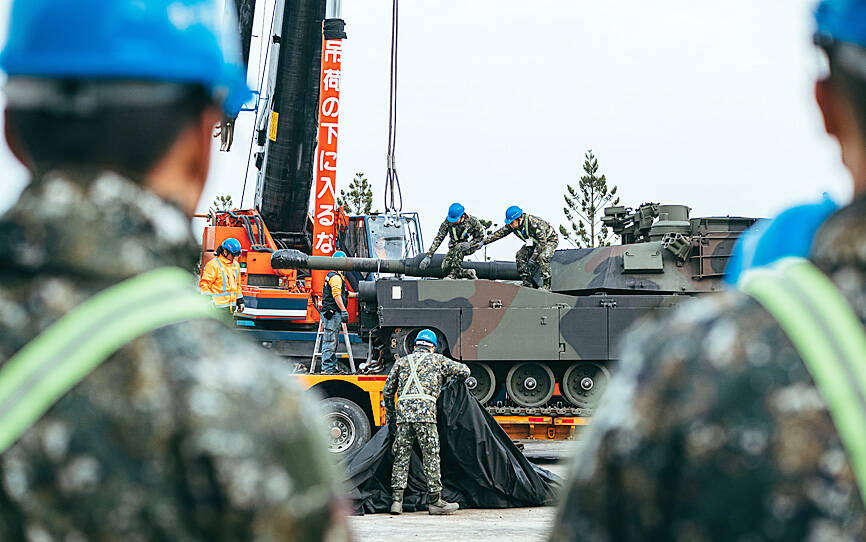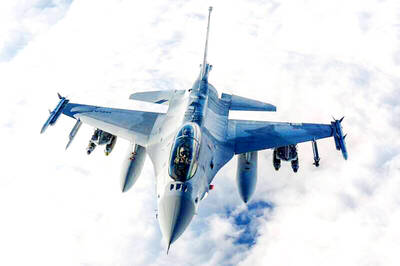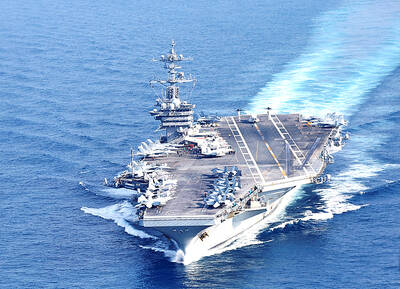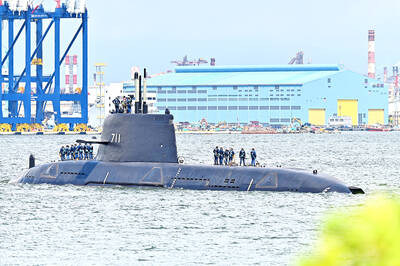Taiwan’s newly procured US weapon systems are to be tested in the 41st annual Han Kuang exercise later this year, the Ministry of National Defense said on Wednesday.
The drills would emphasize responses to “gray zone” activities, speed in preparing for combat, command authority delegation and national-level threat assessment, the ministry’s Joint Operations Planning Division Director Major General Tung Chi-hsing (董冀星) told a regular news conference in Taipei.
The exercises would additionally focus on capabilities for mounting in-depth defense, logistics, civil defense integration and utilizing new weapons systems, he said.

Photo: EPA-EFE / Taiwan Military News Agency
Last year, the armed forces began fielding M1A2T main battle tanks, High Mobility Artillery Rocket Systems, TOW-2B anti-tank guided missiles, land-based Harpoon anti-ship missiles and different types of uncrewed aerial vehicles, among other novel systems, he said.
The drills would test Taiwanese commanders’ ability to effectively utilize these key asymmetric assets operationally, Tung said.
In February, the military’s senior staff held a map-based wargame to design this year’s Han Kuang exercise, he said.
From tomorrow to April 18, the headquarters of various commands would simulate military operations against Chinese People’s Liberation Army (PLA) forces in varying situations ranging from “gray zone” skirmishes to high-intensity conflicts, Tung said.
This part of the drills would make use of the Joint Theater Level Simulation Platform, he said, adding that the headquarters involved are expected to fight continuously for the duration.
Field maneuvers would take place from July 9 to 18 in and around Taiwan proper, including the outlying islands, airspace and surrounding seas, he said.
Leaders at all levels are to design field problems and lead troops in combat practice in their area of responsibility, Tung said.
The field exercises would be held in conjunction with large-scale civil defense drills, including simulated defense of built-up areas, he said.
Military personnel are to conduct the drills fully armed and equipped, and live ammunition would be used in parts of the exercise, Tung added.
Separately, a defense official yesterday said that the fifth mobile squadron of the navy’s Hai Feng Shore-Based Anti-ship Missile Group achieved operational readiness last month, five months after its founding in November last year.
Counting the recently formed mobile squadron, the navy’s dedicated land-based anti-ship missile group consists of 12 squadrons, including six static squadrons, five mobile squadrons and one support squadron, counting the recently formed mobile unit, the source said on condition of anonymity.
Starting on Jan. 1 next year, the Hai Feng Shore-Based Anti-ship Missile Group is expected to be reorganized as the Littoral Combat Command, consisting of northern, central, southern and eastern “strike groups,” they said.
The anti-ship missile group is armed with the indigenously developed Hsiung Feng II and Hsiung Feng III family of missiles and their extended range variants, in addition to US-made Harpoon missiles currently being fielded, they said.
By the time the group’s constituent squadrons receive their full complement of weapons, they would be expected to achieve a 70 percent kill probability against the PLA’s surface combatants and transports, they said.
The Hsiung Feng II missile has an effective range of 148km, while the Hsiung Feng IIE — the extended range variant — has an estimated effective range of 160km to 200km and possesses electronic warfare countermeasures on a par with the most advanced western systems.
The Hsiung Feng III missile has an estimated effective range of 150km to 200km, and a maximum range of 250km.
The Hsiung III missile’s extended range variant entering into service is said to have a maximum range of 400km, significantly more than other systems in the navy’s arsenal.
The AGM-84L-1 Harpoon Block II missiles Taiwan bought from the US are the most updated version of the venerable weapon system with largely classified capabilities.

LONG FLIGHT: The jets would be flown by US pilots, with Taiwanese copilots in the two-seat F-16D variant to help familiarize them with the aircraft, the source said The US is expected to fly 10 Lockheed Martin F-16C/D Block 70/72 jets to Taiwan over the coming months to fulfill a long-awaited order of 66 aircraft, a defense official said yesterday. Word that the first batch of the jets would be delivered soon was welcome news to Taiwan, which has become concerned about delays in the delivery of US arms amid rising military tensions with China. Speaking on condition of anonymity, the official said the initial tranche of the nation’s F-16s are rolling off assembly lines in the US and would be flown under their own power to Taiwan by way

OBJECTS AT SEA: Satellites with synthetic-aperture radar could aid in the detection of small Chinese boats attempting to illegally enter Taiwan, the space agency head said Taiwan aims to send the nation’s first low Earth orbit (LEO) satellite into space in 2027, while the first Formosat-8 and Formosat-9 spacecraft are to be launched in October and 2028 respectively, the National Science and Technology Council said yesterday. The council laid out its space development plan in a report reviewed by members of the legislature’s Education and Culture Committee. Six LEO satellites would be produced in the initial phase, with the first one, the B5G-1A, scheduled to be launched in 2027, the council said in the report. Regarding the second satellite, the B5G-1B, the government plans to work with private contractors

MISSION: The Indo-Pacific region is ‘the priority theater,’ where the task of deterrence extends across the entire region, including Taiwan, the US Pacific Fleet commander said The US Navy’s “mission of deterrence” in the Indo-Pacific theater applies to Taiwan, Pacific Fleet Commander Admiral Stephen Koehler told the South China Sea Conference on Tuesday. The conference, organized by the Center for Strategic and International Studies (CSIS), is an international platform for senior officials and experts from countries with security interests in the region. “The Pacific Fleet’s mission is to deter aggression across the Western Pacific, together with our allies and partners, and to prevail in combat if necessary, Koehler said in the event’s keynote speech. “That mission of deterrence applies regionwide — including the South China Sea and Taiwan,” he

‘NARWHAL’: The indigenous submarine completed its harbor acceptance test recently and is now under heavy guard as it undergoes tests in open waters, a source said The Hai Kun (海鯤), the nation’s first indigenous defense submarine, yesterday began sea trials, sailing out of the Port of Kaohsiung, a military source said. Also known as the “Narwhal,” the vessel departed from CSBC Corp, Taiwan’s (台灣國際造船) shipyard at about 8am, where it had been docked. More than 10 technicians and military personnel were on deck, with several others standing atop the sail. After recently completing its harbor acceptance test, the vessel has started a series of sea-based trials, including tests of its propulsion and navigational systems, while partially surfaced, the source said. The Hai Kun underwent tests in the port from